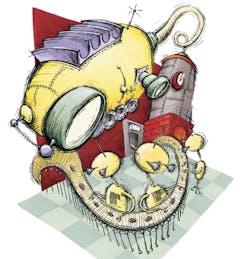Of course, the fact that Motley is account manager for North American Distribution at Fanuc Robotics America, Rochester Hills, Mich., a manufacturer of high-speed articulated robots, no doubt influences his preference. He wouldn’t deny it. Still, he makes a well argued case for his preferred type of robot, and it’s worth lending an ear.
First, let’s take a step back. The Delta was invented in the early 1980s by Raymond Clavel, a professor at the Ecole Polytechnique Federale, in Lausanne, Switzerland. It incorporates three parallelograms mounted on a base that allows an output link to stay in a fixed orientation to the input link. The three legs are organized around a fourth telescopic leg that transmits rotary motion from a motor mounted on the base to the end-effector. Because the legs are hinged and have an arachnid-style angle to them when they move, they are informally known in the industry as spiders.
In 1987, the Swiss firm Demaurex SA purchased a license for the Delta robot and started producing them for the packaging industry. They quickly became popular in the high-speed picking and placing of light-load objects (up to 1 kilograms, or 2.2 pounds) such as candies or chocolate bars because they were the only high-speed robots available to this market other than SCARAs (for selective compliance articulated robot arm). Speeds, according to Motley, generally run from 90 to 150 cycles per minute, a cycle being defined as picking an object, raising it 25 millimeters (mm), moving it 300 mm, lowering it 25 mm to place the object, then returning in the same pattern to pick the next object. Due to their design, Delta robots are mounted above the work area and operate most often in a 1-meter cylindrical workspace.
In 1999, ABB Flexible Automation followed suit, with the production of its FlexPicker Delta-style robot. In the 21st century, this stream became a torrent, particularly as packaging-equipment original equipment manufacturers (OEMs) began incorporating these fast, low-cost robots into their machines and work cells. Their popularity shows no signs of abating.Delta don’ts
But there’s another side to the story. Motley notes that a constraint in the Delta-style design of robots is handling heavier payloads, with speed dropping off as weight is increased. Also, it is difficult to handle longer or bigger products due to moment and inertia restrictions on the wrist axis. With an articulated robot, though, a more powerful motor drives the wrist by direct drive. This allows the handling of bigger and heavier product, such as frozen foods or ice cream cases.
Increased concern with food safety may cause some companies to rethink Delta robots in food handling, he insists. As Deltas can only be mounted directly above the work area, any debris or contamination has only one direction in which to go—down toward the conveyor. In addition, because of their design style, Delta robots often feature external hoses for vacuum grippers or electrical lines.
One of the most glaring design shortfalls with Delta robots where food is concerned is the appearance of external springs at arm joints, according to Motley. “I’d say a spring that expands and could collect contaminants and then collapses and hides them is bad for cleanability and inspectability, two key measures of sanitary design,” Motley says. In contrast to the Delta design, articulated robots can be pedestal-, wall- or floor-mounted so that only the slim arm extends into the food environment, greatly reducing the potential of contamination. In addition, there’s the issue of line maintenance. With the Delta’s overhead design, says Motley, there is always a chance of the grease dripping down into the picking region.
Convinced? Perhaps not, but technical progress depends in part on rational discussion and debate, and Motley’s comments certainly fall within that realm.Related Feature - Vision-Assisted Robotics, an Enabling Technology for PackagingTo read the feature article relating to this story, go towww.automationworld.com/feature-6717.
Subscribe to Automation World's RSS Feeds for Feature Articles

